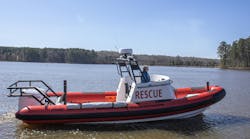Upon analysis many areas of a typical hazmat response can be abbreviated or bypassed in order to save time and still avoid compromising personal safety. Fire Marshal Ted Jarboe from the Montgomery County Fire Department outlined several time-saving techniques for hazmat teams in a Firehouse magazine article from a few years ago such as placing personal protective equipment all the same size in each of the entry personnel's dressing totes or even bypassing the usual pre-entry medical checks. Jarboe's article served as the genesis for our development of a standard operating guideline.
A justification for going without the medical checks applies good old common sense. Since all hazmat personnel are required to have annual fit-for-duty physical exams by a medical doctor they should be capable of affecting a quick entry without a problem. Also, a legitimate point here is that firefighters do not stop for pre-entry medical checks before they enter a structure fire, but which is more physically demanding? Additionally, the OSHA standard for hazmat responses called Hazwoper and even NFPA 472, the standard for hazmat response operations, does not mandate or recommend on-location medical checks. This should not be construed to mean that hazmat personnel should always bypass pre, and post, medical checks but that in rare situations personnel could affect quick entries without these checks for the purpose of saving lives.
Bypassing the application of outer gloves and booties with chemical tape to a vapor proof suit can also save tremendous time that can be used to save lives. This will be especially crucial at terrorism events involving WMD's. Since NFPA 1991 Level A certified suits have attached inner and outer gloves another layer is a waste of time. Certified suits are resistant to a battery of chemicals that include nerve agents and blister agents. A quick entry, then, would entail a self-contained breathing apparatus, a Level A suit, and durable boots. Communication equipment for each entry person is also important inside the suit.
Blitz Entry should be accomplished in less than three minutes after the decision is made. The hazmat team leader should provide a briefing complete with objectives to the entry team while they are dressing. Also, the hazmat team leader and the entry officer should monitor all communications by the entry team. In compliance with Hazwoper, teams of two personnel for entry and backup must be adhered to with all Blitz Entries.
The usual objectives will be to rescue living people or possibly to shut a valve or some other very important task that can be completed quickly. Viable victims include people who have been observed moving and/or breathing, people who have been seen alive in the last 30 minutes, or people who have been able to communicate to responders. In short, are they alive? Can they be saved? Will they still be viable by the time the entry team arrives? These are all good questions to answer and consider before committing personnel to a blitz entry.
The following is a sample SOG that can be utilized for Blitz Entry.
Blitz Entry
This guideline is an option to use at hazardous material and/or terrorism incident where a fast, time-crucial, entry is necessary to save lives or affect a quick resolution to the emergency. It is to be used at the hazardous material team leader's discretion. The following is the dressing procedure and other considerations.
Blitz entry entails a rapid dressing sequence in order to affect a quick entry into a hostile environment for the purpose of life safety or rescue of viable victims. It may also be utilized when quick actions may stabilize rapidly deteriorating conditions. Blitz Entry should be conducted with little to no increase in risk to entry personnel. It will not be used for body recovery.
Dressing Procedure- Utilize Level A suits from PPE totes or bags
- SCBA's will have one hour air cylinders
3. Donn inner gloves and suit. Also place towel inside SCBA shoulder strap.
4. Place hazmat radio on entry channel inside suit and activate
5. Zip up suit completely and apply storm flap
6. Put on protective boots and apply boot straps
7. Conduct radio test by Entry Officer. Safety Officer and Entry Officer will time entry.
Before entry;
Entry;
Safety;
In conclusion, the intent with this generic SOG is to provide hazmat response personnel with a streamlined and systematic method of affecting quick rescues of viable victims with no compromise to entry personnel's health and safety. Respond safely and let's be careful out there!
As usual, any comments or input is greatly appreciated and can be sent to the author at [email protected].





